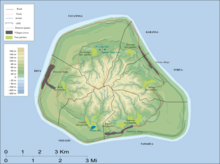
Kei'a (previously Te-apunavai) is one of the six traditional districts of the island of Mangaia, which is part of the Cook Islands archipelago. [1] [2] It is located on the west side of the island, to the south of the District of Tava'enga and west of Veitatei. The district was traditionally divided into 6 tapere : [1]
- Akaoro
- Tapuata
- Tongamarama
- Te-inati
- Rupetau-i-miri
- Rupetau-i-uta
The major habitation is the village of Oneroa, which is home to over half of the island's population. The Auraka cave is also in this district.